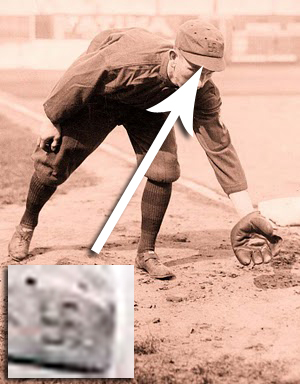In 1914, Boston Braves Wore Hats With Swastikas On Them
There used to be a time when swastikas were thought to bring good luck:
Why were the Boston Braves wearing a swastika on their caps when they opened the 1914 season against the Brooklyn Dodgers?
The swastika’s nearly universal association with Nazi Germany was still years away, although a militarist German youth movement adopted it as a national emblem in 1914. Still, it seems unlikely that the future Hall of Famers Rabbit Maranville and Johnny Evers and the rest of Manager George Stallings’s team meant to inflame racial hatred in Brooklyn by adorning their caps with swastikas.
Swastikas date to 2500 or 3000 B.C. in India and Central Asia. The word is from the Sanskrit svastika, which means good fortune or well-being. It later traveled to Europe, where it was claimed by the Nazi Party around 1920. And it found benign use in the United States on a pendant made by Coca-Cola and as a shoulder patch for the United States Army 45th Infantry division.
Several sports teams, especially in hockey, wore swastikas on their uniforms in the pre-Nazi era, hoping for good luck, said Paul Lukas, the creator of the Uni Watch blog.
“You also see it in Native American imagery as a design,” he added. “It’s a powerful, balanced, impactful design, one reason the Nazis used it.”
If the Braves were hoping the swastika on their caps would bring them luck, they were surely in need of it. They had endured 11 consecutive losing seasons heading into 1914. In 1911, they won only 44 games.
In 2009, Lukas posted a link to a photograph estimated to be from around 1915 of Maranville wearing a cap with a swastika on it. A few months later, Tom Shieber, the senior curator of the Baseball Hall of Fame, analyzed the uniform and the ballpark’s background in the picture and concluded on his Baseball Researcher blog that the photograph was taken on April 14, 1914, opening day at Ebbets Field between the Braves and the Dodgers. The ballpark was in its second season as the home of the Dodgers.
Here’s the photo in question:





I remember when I was growing up in NW Portland there was a house that was built in the late 1800s that had a swastika on the side of the house that was placed there when the house was built. They kept trying to plaster over it but the plaster would fall off and the metal swastika would reappear.
I sure hope Rabbit and Johnny and George aren’t buried near Bergen Community College in Jersey.
The administration there might go and dig them up “to be cleared in a psychiatric exam,” just to be sure they are “following its safety and security procedures, by investigating all situations where a member of its community…expresses a safety or security concern.”
https://www.outsidethebeltway.com/tales-from-the-dumb-side/
Brooklyn would have to wait till 1947 for that…
http://en.wikipedia.org/wiki/Jackie_Robinson#Breaking_the_color_barrier_.281947.29
Look, children pledging allegiance to the American flag with the Nazi salute!
Well, no.
The use of the swastika and the salute both predates the Nazis.
The swastika is originally a Buddhist symbol. The nazis co-opted it and reversed its orientation. Here in Asia you see it in it’s original orientation all the time and people think “Buddhism” not “mindless evi”l when they see it. I live near a temple in Shanghai and the small plaza that houses the Pizza Hut across the street has swastikas inlayed in the entrance courtyard.
I’ve had two encounters with this reality. The first was when I was in college and we went to the home of a Professor of Anthropology. We were chatting in his room when I noticed swastika on the table. He noticed my gaze and explained that it was not considered bad in the region of the world he studied (Nepal). Also was once at an Indian wedding where a curtain was raised that had a swastika on it. The groom was very nervous because there was an Orthodox Jewish wedding down the hall.
I was aware of some Indian uses, but didn’t know much more about the history. It is too bad a well-balanced symbol was forever ruined.
@Franklin: “It is too bad a well-balanced symbol was forever ruined.”
That remains to be seen. Symbols are precisely what one says they are. No more. No less. If it could be used harmlessly on a baseball cap, clearly the symbol itself is not at fault.
Until we take back these symbols, they will continue to haunt us. Same with words. For example, could a film such as Blazing Saddles even get made today? Such art uncovers an important truth:”being offended” remains a choice.
Mindless evil …like this…?
“A Buddhist mob rampaged through a town in an isolated corner of Myanmar, hacking Muslim women and children with knives,..”
http://www.huffingtonpost.com/2014/01/16/mynanmar-buddhist-mob-kills-muslims_n_4610496.html
The Nazis turned the swastika onto a point though, didn’t they?
Every use of it outside Nazism usually has it like the hat does, resting on a flat side.
I saw swastikas on Bhuddist locations in Seoul, Korea, when stationed there ten years ago.
@MarkedMan:
They are or were 15 years ago on light poles all over Glendale, CA.